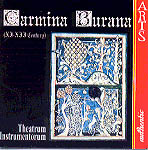On the surface, meaning in terms of the sound of instruments and voices, this is yet another of several imaginative and effective realizations of songs from the famous 13th-century manuscript discovered in a Bavarian monastery in 1803. Although the liner notes allude to the fact that in most cases the song texts were not notated, or contain ambiguous melodic and rhythmic information, we are not told exactly from where this fine early-music ensemble obtained its musical material. The implication is that, as with virtually all other modern groups who perform these pieces, they “reproposed”–or, essentially made up–the melodies and rhythms and instrumentation based on solid musicological and perfoming-practice evidence. And the result certainly is satisfying for its very colorful array of instrumental accompaniments and stylish vocal renditions of texts that represent the manuscript’s range of primarily secular but occasionally sacred themes. The mood is celebratory and lively, and the instruments–used in various configurations–make an impressive ensemble: lute, gittern, harp, fiddles, flute, recorder, shawm, bagpipe, hurdy-gurdy, tabor, jew’s harp, tambourine, tammorra, and castanets.
Listeners familiar with Carl Orff’s 20th-century masterpiece very loosely based on Carmina Burana’s texts and themes will appreciate that here the Theatrum Instrumentorum has chosen to set its own versions of two of Orff’s songs–“In taberna quando sumus” and “Tempus est iocundum”. And although the present renditions, with suitably characterful (as in raucous) vocal interpretations in the tavern scene and unbridled joy in “Tempus est iocundum”, are solid and well-thought-out, you can’t help but think Orff’s ideas are the more successful for their catchy tunes and rhythms, especially on a purely popular-appeal level for today’s audiences. Nevertheless, I really enjoyed this disc and appreciate its richly colored settings and expert performances. I suppose this fascinating manuscript will never cease to entice performers to offer their own interpretations of its often racy, irreverent texts–and if they’re this well-conceived, that will be a good thing for early-music listeners.
































